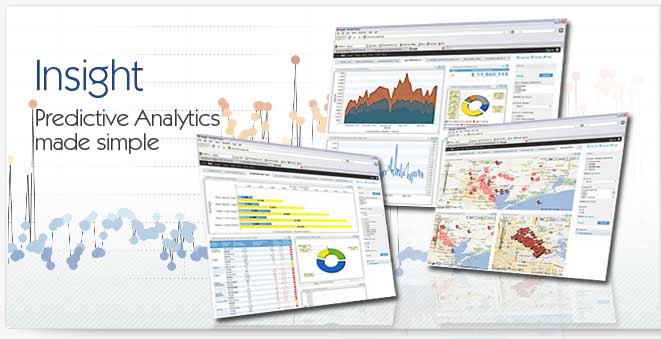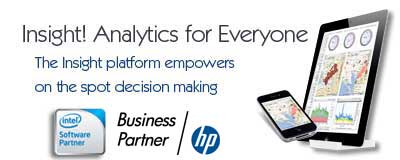Dashboarding Software
The term "dashboarding software" refers to data analysis platforms that are used to gather and analyze vast amounts of data with the ultimate goal of presenting the results to business users in the form of "dashboards" that combine multiple reports in an interactive metaphor that allows business users to understand business trends and analyze critical data. Dashboarding software has been in existence for some time, but over the past five years has enjoyed a significant boost in popularity and need based on a number of key factors. One of the most critical drivers of adoption of dashboarding software is the rapid growth of data that is stored by businesses. By some estimates the World creates as much data in a single week as was created from the beginning of recorded history to the end of 2010! With the advent of low-cost storage, more affordable enterprise software solutions, and affordable server platforms, businesses of all sizes are beginning to find that the amount of "data" they have available is becoming unwieldy - and the process of analyzing it and discovering patterns in it is becoming impossible.
Dashboarding Software, The Hard Part
Enterprise organizations have always known that dashboarding software provides a powerful means for business users to analyze data and discover important trends and patterns. The challenge, however, has always been the process of building these dashboards. There are two key reasons why dashboarding software has proven to be difficult to use and deploy until recently. First, the language that dashboarding systems use to communicate with data sources is based on the SQL language that powers the vast majority of the world's enterprise systems. SQL language is complex, requires a high degree of specialization and is subject to potential errors that can often lead to huge mistakes in resulting calculations. The second complexity of dashboarding software has been the relatively high complexity and costs that come with the deployment and management of dashboarding environments. In fact, it has been historically quite common to pay multiple hundreds of thousands of dollars to implement and begin using a dashboarding system.
Dashboarding Software and the Browser
Dashboarding software has begun to change radically with the advent of software as a service platforms (SaaS). The idea of leveraging a computer's web browser to deliver an enterprise application brings significant merits with it. One of the biggest benefits of using a web browser to deploy enterprise software is the massive time savings it provides. More specifically, with browser-based platforms IT organizations no longer have to waste countless hours moving from desktop to desktop installing software. Users are simply created in the system and are provided with a URL that points to the software. The challenge of SaaS software for dashboarding is one of security - specifically, organizations are hesitant to allow their most valuable asset, their data, to be sent over the internet to a third part (the SaaS provider). During the past few years a new alternative has become available: in-house software that leverages the technologies of SaaS dashboarding software and allows for a 100% browser-based experience, but does not require data to be sent externally from the organization.
Dashboarding Software and the User
The second challenge of dashboarding software is the user interface. Traditionally, dashboarding software has been predicated on one basic assumption: that organizations had ample IT resources who would be available to create reports using the complex SQL language that was critical to find data in source systems and report on it. As the volume of data has grown, however, organizations are finding that business users want access to more information - and in less time. This has placed an increasing amount of pressure on already strained IT resources to keep up with demand and provide an exponentially growing number of reports and dashboards. Advancements in user interface technologies have come to the rescue. A number of startup organizations have pioneered easy to use, 100% browser-based dashboarding software platforms that provide the level of simplicity necessary to allow business users to create reports and dashboards without, or with minimal, involvement from IT. This "self-service" model is becoming increasingly vital to allow businesses both large and small to have the flexibility and speed necessary to respond to changing market conditions quickly.
Dashboarding Software and Mobility: Taking it on the road
The latest trend in dashboarding software has to do with mobility. The rapid rise of smartphone and tablet platforms over the past five years has created an ever-increasing demand for dashboarding platforms that can easily interact with these new mobile devices. Despite their capabilities, however, mobile platforms present a challenge for any dashboarding software platform. The large difference in display area between a typical desktop environment and a smartphone or tablet alternative means dashboarding platforms can be challenged when presenting charts and dashboard to such small screens. Couple this with the "touch-based" interaction that is the foundation of these new mobile devices, and dashboards quickly can become unwieldy or even completely impractical on mobile devices. There are two competing models for resolving this problem. The first provides for reports and dashboards to be re-formatted at the server before they are provided to dedicated mobile applications. While this provides for the most sophisticated mobile experience possible, it also creates a huge bottleneck between the available reports and the mobile need - since any report must be "reformatted" prior to becoming mobile "ready." Once again, a compelling new set of alternatives is becoming available that provides for the seamless publishing of charts and dashboards to dedicated mobile devices without having to reformat reports. While the user experience of these new platforms is not as advanced yet as its earlier alternatives, the rapid pace of development and adoption of technologies like HTML 5 are making it very likely that the "create once, publish anywhere" approach will become the dominant form in the near future.
|



